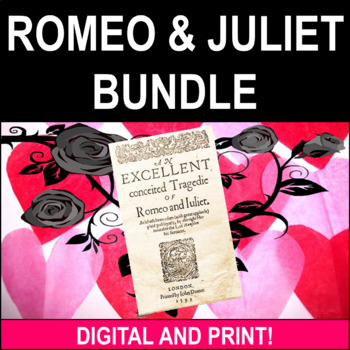Romeo and Juliet Bundle - DIGITAL
- Zip
- Google Apps™

Products in this Bundle (4)
Bonus
Description
This unit was planned using backward design and a UbD template to ensure that all the diverse learner needs are being met in the classroom.
A detailed Understanding by Design Unit Plan is included incorporating the following:
- The unit starts with a Drama foldable project, where students make a foldable using different drama terms they will encounter throughout the unit. They need definitions with a visual association and using the term in a sentence. They also do a WebQuest on William Shakespeare to understand why it is important to learn about him as an author and read one of his famous plays. (Acquisition)
- Prologue activity where students learn the prologue through finding definitions to unknown words, understanding stanzas and couplets, iambic pentameter, and answering clarifying questions. Through this activity, students are introduced to paraphrasing. (Meaning)
-Reading Plot Card guides for each scene and act with embedded questions for short answer responses. Text-dependent questions after each act, and a chance to summarize each scene. Paraphrase activities with Romeo’s soliloquy in Act II, scene II, Juliet’s soliloquy in Act IV, scene III, and Act V, scene II. (Meaning)
-Reciprocal teaching activity for Act III, scene I, where students have different tasks and the scene is chunked into four different parts. Students are either the questioner, clarifier, summarizer, or predictor. These roles should be predetermined based on the student’s academic needs. Each student does their role and then teaches what they learned to their peers. Students get to focus on one skill while learning and teaching the other skills to their peers. Collaborative skills are being learned while students are applying their learning by digging deeper underneath the text to understand the deeper meaning and subtext. (Meaning)
-Evidence collector- students are given a graphic organizer that helps them find evidence to support the emotion they have chosen to analyze throughout the play. They complete this during and after each Act. Then there are posters on the walls for each act and as a class, we discuss the four main emotions the students have chosen to focus on. Each student must find a quote and write the means and matters on the poster under the appropriate emotion. They will continue to do this and trace the emotion until the end of the play. The class has a gallery walk at the end of the act and students read the different emotions, quotes, means, and matters to reflect, rethink, and possibly revise their evidence collector. (Transfer)
-Summative essay outline peer revision opportunities are given, and students pick a peer to read and revise/edit their work. This gives students the opportunity to look at the suggestions and evaluate if they are needed. Students learn by assessing other students. It allows all students feedback from their peers and they can evaluate their progress and self-assess on the rubric provided. (Transfer)
-Summative project where students get to be creative and use their imagination! This project will give students the chance to draw a map of Verona, and understand the character's motivations by advertising a shop or product that each character would sell. (Transfer)
-Students are encouraged to use props and costumes when performing the scenes. Students are given a choice as to whether they would like to perform the original Shakespearean text or their paraphrased text. Extra time is given to EL students, and students with an IEP or 504 plans to complete assignments. Sentence starters and frames are provided for students who need extra support.
-Each lesson was carefully and purposefully created to scaffold learning to reach the goals of the unit. The Gradual Release Responsibility (GRR) instruction framework has been used to organize and sequence this unit. The unit starts with focused instruction (Direct instruction and modeling all activities), moves into guided instruction (Activities done as a class and discussed), collaborative learning (Formative responses, Reciprocal Teaching, Paraphrasing), and then finally independent learning (Summative Essay).
Quiz on Shakespeare's background and Drama elements.
Quizzes for each act, a final 100 question test, and a shortened final are included with teacher keys!
ALL documents are EDITABLE.
GOOGLE FORMS FOR ALL TESTS AND QUIZZES INCLUDED!!
Feedback & Followers:
If you enjoy this unit, please leave a review! It enables teachers to find valued products. If you have suggestions to improve this product let me know! Follow my page so you can be updated when I upload new products :)
~~~~~~~~~~~~~~~~~~~~~~~~~~~~~~~~~~~~~~~~~~~~~~~~~~~~~~~~~~~~~~~~~~~~~~~
This download license is intended for one teacher only. Please refer colleagues to my store. This product is strictly for personal use and should not be shared on the internet in any form. Thank you for respecting the hard work put into this product!


